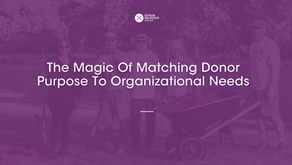Crafting the Perfect Donor Welcome: How to Create an Engaging and Inspiring Email Series
- Lynne Wester

- Aug 7, 2024
- 3 min read

A donor has chosen your organization to receive a gift—Congratulations! Now, what’s next? Beyond sending a prompt tax receipt and acknowledgment letter, the key to retention is cultivating a lasting relationship that ensures they feel valued and motivated to continue giving. This pivotal moment calls for a strategic approach: the creation of a compelling welcome email series.
Welcome Emails Matter
Welcome emails are more than just an initial thank you; they are the foundation for building donor loyalty and engagement.They offer a unique opportunity to introduce new supporters to your organization’s vision, impact, and the tangible difference their contribution makes.By nurturing this relationship from the start, you set the stage for long-term commitment and potential major gifts.
Crafting Your Welcome Series
To maximize the impact of your welcome series, follow these essential steps:
1. Set Clear Goals:
Goal 1: Warmly welcome and express gratitude.
Goal 2: Demonstrate the immediate impact of their donation.
Goal 3: Deepen your donors connection to your organization.
Goal 4: Foster engagement through two-way communication and feedback.
Goal 5: Establish a regular communication schedule to keep donors informed and connected.
2. Segment Your Audience:
Determine who will receive each email based on donor type (first-time, monthly, lapsed, etc.). Tailoring your message ensures relevance and personalization.
3. Craft Compelling Content:
Make your emails visually appealing with high-quality images, videos, and infographics.
Share impactful stories that highlight how donations are changing lives.
Provide behind-the-scenes glimpses to showcase your organization’s dedication and transparency.
Educate donors about broader issues related to your cause to deepen their understanding and connection.
4. Plan Your Email Sequence:
Send a series of 3-5 emails over a 6 month time period to maintain interest without overwhelming.
Each email should seamlessly build upon the last, guiding donors on their journey deeper into your organization’s work and impact.
5. Include Strong Calls-to-Action:
Encourage further engagement such as opting in for newsletters, joining fundraising campaigns, or becoming recurring donors.
Make it easy for donors to take the next step with clear, compelling calls-to-action.
Industry Examples
Let’s draw inspiration from organizations like charity: water and Dare to Care Food Bank, who excel in donor engagement through effective welcome email strategies:
charity: water: Utilizes a series that begins with warm welcomes and progresses through impactful stories, behind-the-scenes insights, educational content, and clear invitations to deepen involvement.
Email 1: Welcome and Impact Introduction
Subject Line: "Welcome to the charity: water Family!"
Content: Introduces the organization's mission to provide clean and safe drinking water to people in developing countries. Expresses gratitude for the donor's support and explains how their donation will make a direct impact on improving lives.
Email 2: Impact Story
Subject Line: "See the Impact of Your Support"
Content: Shares a compelling story of a community that has benefited from clean water projects funded by donations. Includes photos and personal testimonials to illustrate the transformation brought about by their contributions.
Email 3: Behind-the-Scenes
Subject Line: "A Day in the Life at charity: water"
Content: Offers a behind-the-scenes look into the organization's operations, highlighting the dedication of their team and the innovative approaches used to implement water projects effectively.
Email 4: Educational Content
Subject Line: "Learn More About the Global Water Crisis"
Content: Provides informative content about the global water crisis, including statistics, challenges, and solutions. Educates donors on the broader context of the issue their donations are addressing.
Email 5: Call to Action
Subject Line: "Join Us in Bringing Clean Water to More Communities"
Content: Encourages donors to deepen their involvement with charity: water by participating in fundraising campaigns, signing up for newsletters, or becoming recurring donors. Provides clear steps on how they can continue supporting the cause.
Dare to Care Food Bank: Focuses on visual appeal, segmentation, personalization, and leveraging automation tools to ensure each donor feels connected and valued.

Tips for Success:
Visual Appeal: Use visually appealing content to captivate donors from the first glance.
Segmentation: Tailor your messages based on donor preferences and history for personalized communication.
Personalization: Address donors by name and speak directly to their interests and impact.
Automation and Analytics: Leverage tools for scheduling and analyzing email performance to continuously optimize your strategy.
A well-crafted welcome email series is not just a formality—it’s your chance to inspire, inform, and engage donors in a meaningful way. By implementing these strategies and taking cues from leading nonprofits, you can turn first-time supporters into lifelong advocates for your cause. Start planning your welcome series today to create lasting impact and build a community of dedicated supporters!





